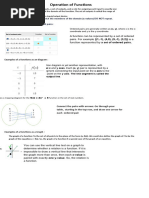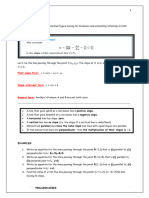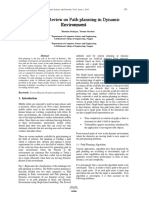KEY_Guided Notes - Functions
Uploaded by
j5nvx7ctt9KEY_Guided Notes - Functions
Uploaded by
j5nvx7ctt9Name: Date:
Functions
Objective
In this lesson, you will use a function to model and analyze a relationship between two
quantities.
Function: a relation between two variables in which
each value of the independent variable (x) maps to one, and only one, value of
the dependent variable (y)
Function Representations
The value of the independent
Independent variable: a quantity that changes freely
variable is called the input
and may determine the value of other variables
Dependent variable: a quantity that changes in response to changes The value of the dependent
in another variable variable is called the output
©Edmentum. Permission granted to copy for classroom use.
In this function, the independent variable is time , t, and the dependent variable is
height , h. In function notation, the height is represented as ℎ(𝑡𝑡).
Guided Notes: Functions 1
If 𝒙𝒙 = 𝟔𝟔, find 𝒇𝒇(𝟔𝟔). If 𝒈𝒈(𝒙𝒙) = −𝟒𝟒𝟒𝟒, find 𝒙𝒙.
Consider these functions. 𝑓𝑓(𝑥𝑥) = −9𝑥𝑥 + 14 𝑔𝑔(𝑥𝑥) = −3𝑥𝑥 2
𝑓𝑓(𝑥𝑥) = −9𝑥𝑥 + 14 𝑓𝑓(6) = −9( 6 ) + 14 -48 = −3𝑥𝑥 2
= -54 +14 16 = 𝑥𝑥 2
𝑔𝑔(𝑥𝑥) = −3𝑥𝑥 2
= -40 ± 4 = 𝑥𝑥
FUNCTION REPRESENTATIONS
A relation is an association between two variables, where one variable is dependent on the
other variable.
Verbal Description Equation
In the 10–19 age group, there are 48 riders
per hour. In the 20–29 age group, there are
24 riders per hour. In the 30–39 age group,
there are 12 riders per hour. To find the number of riders for a specific age group,
For each age group, the number of riders substitute the appropriate value of a into
is half as many as the previous group. the equation and simplify.
Table Graph
©Edmentum. Permission granted to copy for classroom use.
The table shows these ordered pairs for this
function: Age is represented horizontally . The
(0, 48 ), (1, 24 ), (2, 12 ), (3, 6 ), (4, 3 ) number of riders is represented vertically .
These representations all describe an exponential relationship, in which the number of riders in each
group is half as many as in the previous group.
Guided Notes: Functions 2
IDENTIFYING FUNCTIONS
For a relation to be a function, every input must have exactly one output . To see whether a graph
represents a function, we can use the vertical line test. If no vertical line intersects the function at
more than one point , the relation is a function.
Function?
Relation Reasoning
(Yes/No)
Every value of x corresponds to exactly one value
Yes
of y . If x = 4, y = 24, or 16.
The x-value of -2 is paired with two different
No
y-values ( 3 and 4 ).
The x-value of 4 is paired with two different
No
y-values ( 20 and 30 ).
It passes the vertical line test.
Yes No two y -values (points on the graph) have the
same x -value.
©Edmentum. Permission granted to copy for classroom use.
Key Features
A function’s equation, table, or graph can reveal many key features of the function.
Guided Notes: Functions 3
Linear Function
• End behavior: The function is
always decreasing .
As x approaches infinity ,
f(x) approaches negative infinity.
• Intercepts: The x-intercept is ( 2 ,0). The y-intercept
is ( 0 ,6).
• Slope: The function’s slope (change in y divided by change in x ) equals -3 .
• Positive interval: (-∞, 2 )
• Negative interval: ( 2 , ∞)
Quadratic Function
• Vertex: the highest
(maximum) or lowest
(minimum) point, where the graph
changes from decreasing to
increasing.
©Edmentum. Permission granted to copy for classroom use.
• Axis of symmetry: a vertical line that passes through the
vertex , marking the symmetry of the graph
• Intercepts: The x -intercepts are located where g(x) = 0. The y -intercept is located
where x = 0.
• Negative interval: This function is negative between the x -intercepts.
• Positive interval: This function is positive for every other value of x.
Guided Notes: Functions 4
DOMAIN AND RANGE
Domain: the set of values for which an independent variable is defined
Range: the set of values for which a dependent variable is defined
This exponential function is always increasing
(this occurs when the base of an
exponential function is greater than 1 .)
As the value of x approaches negative infinity, the
value of h(x) approaches, but never reaches 4 .
The horizontal line y = 4 is called
an asymptote .
©Edmentum. Permission granted to copy for classroom use.
A function’s domain and range can be described in several ways.
Inequalities Set Notation Interval Notation
𝑦𝑦 ≥ 4 {𝑥𝑥 ∈ ℝ|4 < 𝑥𝑥 < ∞} [4, ∞)
Guided Notes: Functions 5
Different types of functions follow different patterns for their domains and ranges.
Linear Quadratic Exponential
Graph
−∞ < 𝑥𝑥 < ∞ −∞ < 𝑥𝑥 < ∞ −∞ < 𝑥𝑥 < ∞
Domain
(−∞, ∞) (−∞, ∞) (−∞, ∞)
{𝑥𝑥 ∈ ℝ|−∞ < 𝑥𝑥 < ∞} {𝑥𝑥 ∈ ℝ|−∞ < 𝑥𝑥 < ∞} {𝑥𝑥 ∈ ℝ|−∞ < 𝑥𝑥 < ∞}
−∞ < 𝑦𝑦 < ∞ 𝑦𝑦 > 4 𝑦𝑦 ≥ −1
Range
(−∞, ∞) (4, ∞) [−1, ∞)
{𝑦𝑦 ∈ ℝ|−∞ < 𝑦𝑦 < ∞} {𝑦𝑦 ∈ ℝ|𝑦𝑦 > 4} {𝑦𝑦 ∈ ℝ|𝑦𝑦 ≥ −1}
©Edmentum. Permission granted to copy for classroom use.
The domain and range contain an infinite This function does not include every value within
number of values within their boundaries, so this is the boundaries of the domain and
a continuous function. range, so it is a discrete function.
Guided Notes: Functions 6
Parent Functions
A function family is a group of functions that have the same parent function.
Parent functions are the simplest function of a certain degree.
LINEAR FUNCTION TRANSFORMATIONS Parent Function
The parent linear function has its x- and y-intercepts at the
origin . It has a slope of 1 .
𝑓𝑓(𝑥𝑥) = 𝑥𝑥
Type of transformation: Type of transformation: Type of transformation:
Reflection Dilation Translation
©Edmentum. Permission granted to copy for classroom use.
When the parent function is Multiplying by a number greater Adding a number translates the
multiplied by -1 , it is reflected than 1 stretches it function up . Subtracting a
vertically. Multiplying by a number translates the function
across the x -axis.
positive number less than 1 down .
compresses it towards
the x-axis.
Guided Notes: Functions 7
QUADRATIC FUNCTION TRANSFORMATIONS
Quadratic functions can be reflected, dilated, and translated in the same way as linear functions.
a c Match each equation with its graph.
a 𝑦𝑦 = 𝑥𝑥 2 (parent function)
d
c 𝑦𝑦 = 3𝑥𝑥 2
b
b 𝑦𝑦 = −𝑥𝑥 2 + 5
d 𝑦𝑦 = (𝑥𝑥 − 5)2
EXPONENTIAL FUNCTION TRANSFORMATIONS
Exponential functions can be reflected, dilated, and translated in the same way as linear functions.
a Match each equation with its graph.
a 𝑦𝑦 = 2𝑥𝑥 (parent function)
b
b 𝑦𝑦 = 4(2)𝑥𝑥 ©Edmentum. Permission granted to copy for classroom use.
c d 𝑦𝑦 = 2𝑥𝑥 − 5
d
c 𝑦𝑦 = −2𝑥𝑥 + 5
Guided Notes: Functions 8
You might also like
- Review of The Mathematical Foundation: Lesson 1No ratings yetReview of The Mathematical Foundation: Lesson 18 pages
- Functions of Several Variables (Multi Variables Functions) : Assoc. Prof. Dr. Rozlan AliasNo ratings yetFunctions of Several Variables (Multi Variables Functions) : Assoc. Prof. Dr. Rozlan Alias44 pages
- Examples of A Functions As An Ordered PairsNo ratings yetExamples of A Functions As An Ordered Pairs3 pages
- Multivariable Calculus - Unit4 - by Dr. Tadesse Bekeshie100% (2)Multivariable Calculus - Unit4 - by Dr. Tadesse Bekeshie48 pages
- LAB#2 Implementation of Constants, Variables and ExpressionsNo ratings yetLAB#2 Implementation of Constants, Variables and Expressions6 pages
- Ray Tracing Harmonic Functions - Mark Gillespie & Denise Yang &_3640No ratings yetRay Tracing Harmonic Functions - Mark Gillespie & Denise Yang &_364018 pages
- Machine Learning - Home - Week 2 - Notes - CourseraNo ratings yetMachine Learning - Home - Week 2 - Notes - Coursera10 pages
- First Elements Ordered Pairs Set Second Elements: RelationNo ratings yetFirst Elements Ordered Pairs Set Second Elements: Relation9 pages
- General Mathematics: Functions and Their Graphs100% (2)General Mathematics: Functions and Their Graphs5 pages
- 2.2_More on Functions and Graphs_1113 (1)No ratings yet2.2_More on Functions and Graphs_1113 (1)3 pages
- Objective: Represent and Identify FunctionNo ratings yetObjective: Represent and Identify Function30 pages
- Differential Calculus Lecture Notes 2023No ratings yetDifferential Calculus Lecture Notes 20232 pages
- GenMath - MODULE 1 - Lessons 1-4 - Function As Machine, Evaluation, Operations, and Composition of Function - UpdatedNo ratings yetGenMath - MODULE 1 - Lessons 1-4 - Function As Machine, Evaluation, Operations, and Composition of Function - Updated72 pages
- 22 Clarifying Big Ideas_ Analyzing Quantitative DataNo ratings yet22 Clarifying Big Ideas_ Analyzing Quantitative Data2 pages
- 16 Clarifying Big Ideas_ Analyzing Quantitative DataNo ratings yet16 Clarifying Big Ideas_ Analyzing Quantitative Data2 pages
- 8.3 Clarifying Big Ideas_ Analyzing Quantitative DataNo ratings yet8.3 Clarifying Big Ideas_ Analyzing Quantitative Data2 pages
- Sample Stand Out, Fourth Edition Basic Student's BookNo ratings yetSample Stand Out, Fourth Edition Basic Student's Book25 pages
- Edmentum_Matter and Energy_ Mastery TestNo ratings yetEdmentum_Matter and Energy_ Mastery Test6 pages
- 24 Clarifying Big Ideas_ Analyzing Quantitative DataNo ratings yet24 Clarifying Big Ideas_ Analyzing Quantitative Data1 page
- 8.4 Clarifying Big Ideas_ Analyzing Quantitative DataNo ratings yet8.4 Clarifying Big Ideas_ Analyzing Quantitative Data2 pages
- 14 Clarifying Big Ideas_ Analyzing Quantitative DataNo ratings yet14 Clarifying Big Ideas_ Analyzing Quantitative Data1 page
- 23 Clarifying Big Ideas_ Analyzing Quantitative DataNo ratings yet23 Clarifying Big Ideas_ Analyzing Quantitative Data1 page
- Edmentum_20 Clarifying Big Ideas_ Analyzing Quantitative DataNo ratings yetEdmentum_20 Clarifying Big Ideas_ Analyzing Quantitative Data2 pages
- KEY_Guided Notes - Equations and InequalitiesNo ratings yetKEY_Guided Notes - Equations and Inequalities7 pages
- [FREE PDF sample] (Ebook) Quantum Measurement Theory and its Applications by Kurt Jacobs ISBN 9781107025486, 9781139179027, 1107025486, 1139179020 ebooks100% (2)[FREE PDF sample] (Ebook) Quantum Measurement Theory and its Applications by Kurt Jacobs ISBN 9781107025486, 9781139179027, 1107025486, 1139179020 ebooks67 pages
- Slide 3 - Linear Regression One VariableNo ratings yetSlide 3 - Linear Regression One Variable60 pages
- A Comparison of Two Linear Algebra BooksNo ratings yetA Comparison of Two Linear Algebra Books3 pages
- A Review of Deep Learning Models To Detect Malware in Android ApplicationsNo ratings yetA Review of Deep Learning Models To Detect Malware in Android Applications9 pages
- Matlab Quick Reference: Built-In Matrices Logical IndexingNo ratings yetMatlab Quick Reference: Built-In Matrices Logical Indexing2 pages
- Genetic Algorithm - Investment Decision MakingNo ratings yetGenetic Algorithm - Investment Decision Making6 pages
- Machine_Learning_Approaches_to_Predict_Asthma_ExacNo ratings yetMachine_Learning_Approaches_to_Predict_Asthma_Exac19 pages
- Module 4: Dynamic Programming: Design and Analysis of Algorithms 21CS42No ratings yetModule 4: Dynamic Programming: Design and Analysis of Algorithms 21CS42105 pages
- Contents - 2023 - A New Approach To HAZOP of Complex Chemical ProcessesNo ratings yetContents - 2023 - A New Approach To HAZOP of Complex Chemical Processes5 pages
- 4-6-normal-distributions-003eCoyDOpsVHlU3No ratings yet4-6-normal-distributions-003eCoyDOpsVHlU339 pages
- Dr. Huma Qayyum Department of Software Engineering Huma - Ayub@uettaxila - Edu.pkNo ratings yetDr. Huma Qayyum Department of Software Engineering Huma - Ayub@uettaxila - Edu.pk20 pages
- Lab-4: Regression Analysis: Logistic & Multinomial Logistic RegressionNo ratings yetLab-4: Regression Analysis: Logistic & Multinomial Logistic Regression10 pages
- Pattern Generating Procedure For The Cutting Stock ProblemNo ratings yetPattern Generating Procedure For The Cutting Stock Problem9 pages
- CSC384: Intro To Artificial Intelligence Game Tree Search II Midterm: Everything Covered So Far Plus This Lecture SlidesNo ratings yetCSC384: Intro To Artificial Intelligence Game Tree Search II Midterm: Everything Covered So Far Plus This Lecture Slides19 pages
- Natural Response Neither Grows Nor Approaches Zero As Time (ForNo ratings yetNatural Response Neither Grows Nor Approaches Zero As Time (For9 pages
- Functions of Several Variables (Multi Variables Functions) : Assoc. Prof. Dr. Rozlan AliasFunctions of Several Variables (Multi Variables Functions) : Assoc. Prof. Dr. Rozlan Alias
- Multivariable Calculus - Unit4 - by Dr. Tadesse BekeshieMultivariable Calculus - Unit4 - by Dr. Tadesse Bekeshie
- LAB#2 Implementation of Constants, Variables and ExpressionsLAB#2 Implementation of Constants, Variables and Expressions
- Ray Tracing Harmonic Functions - Mark Gillespie & Denise Yang &_3640Ray Tracing Harmonic Functions - Mark Gillespie & Denise Yang &_3640
- Machine Learning - Home - Week 2 - Notes - CourseraMachine Learning - Home - Week 2 - Notes - Coursera
- First Elements Ordered Pairs Set Second Elements: RelationFirst Elements Ordered Pairs Set Second Elements: Relation
- GenMath - MODULE 1 - Lessons 1-4 - Function As Machine, Evaluation, Operations, and Composition of Function - UpdatedGenMath - MODULE 1 - Lessons 1-4 - Function As Machine, Evaluation, Operations, and Composition of Function - Updated
- A-level Maths Revision: Cheeky Revision ShortcutsFrom EverandA-level Maths Revision: Cheeky Revision Shortcuts
- 22 Clarifying Big Ideas_ Analyzing Quantitative Data22 Clarifying Big Ideas_ Analyzing Quantitative Data
- 16 Clarifying Big Ideas_ Analyzing Quantitative Data16 Clarifying Big Ideas_ Analyzing Quantitative Data
- 8.3 Clarifying Big Ideas_ Analyzing Quantitative Data8.3 Clarifying Big Ideas_ Analyzing Quantitative Data
- Sample Stand Out, Fourth Edition Basic Student's BookSample Stand Out, Fourth Edition Basic Student's Book
- 24 Clarifying Big Ideas_ Analyzing Quantitative Data24 Clarifying Big Ideas_ Analyzing Quantitative Data
- 8.4 Clarifying Big Ideas_ Analyzing Quantitative Data8.4 Clarifying Big Ideas_ Analyzing Quantitative Data
- 14 Clarifying Big Ideas_ Analyzing Quantitative Data14 Clarifying Big Ideas_ Analyzing Quantitative Data
- 23 Clarifying Big Ideas_ Analyzing Quantitative Data23 Clarifying Big Ideas_ Analyzing Quantitative Data
- Edmentum_20 Clarifying Big Ideas_ Analyzing Quantitative DataEdmentum_20 Clarifying Big Ideas_ Analyzing Quantitative Data
- [FREE PDF sample] (Ebook) Quantum Measurement Theory and its Applications by Kurt Jacobs ISBN 9781107025486, 9781139179027, 1107025486, 1139179020 ebooks[FREE PDF sample] (Ebook) Quantum Measurement Theory and its Applications by Kurt Jacobs ISBN 9781107025486, 9781139179027, 1107025486, 1139179020 ebooks
- A Review of Deep Learning Models To Detect Malware in Android ApplicationsA Review of Deep Learning Models To Detect Malware in Android Applications
- Matlab Quick Reference: Built-In Matrices Logical IndexingMatlab Quick Reference: Built-In Matrices Logical Indexing
- Machine_Learning_Approaches_to_Predict_Asthma_ExacMachine_Learning_Approaches_to_Predict_Asthma_Exac
- Module 4: Dynamic Programming: Design and Analysis of Algorithms 21CS42Module 4: Dynamic Programming: Design and Analysis of Algorithms 21CS42
- Contents - 2023 - A New Approach To HAZOP of Complex Chemical ProcessesContents - 2023 - A New Approach To HAZOP of Complex Chemical Processes
- Dr. Huma Qayyum Department of Software Engineering Huma - Ayub@uettaxila - Edu.pkDr. Huma Qayyum Department of Software Engineering Huma - Ayub@uettaxila - Edu.pk
- Lab-4: Regression Analysis: Logistic & Multinomial Logistic RegressionLab-4: Regression Analysis: Logistic & Multinomial Logistic Regression
- Pattern Generating Procedure For The Cutting Stock ProblemPattern Generating Procedure For The Cutting Stock Problem
- CSC384: Intro To Artificial Intelligence Game Tree Search II Midterm: Everything Covered So Far Plus This Lecture SlidesCSC384: Intro To Artificial Intelligence Game Tree Search II Midterm: Everything Covered So Far Plus This Lecture Slides
- Natural Response Neither Grows Nor Approaches Zero As Time (ForNatural Response Neither Grows Nor Approaches Zero As Time (For













































































































